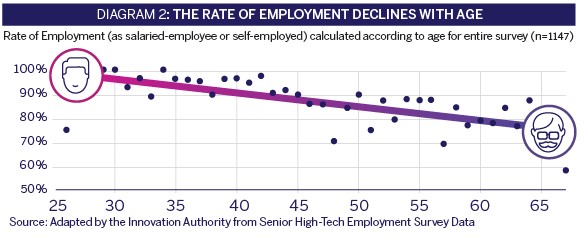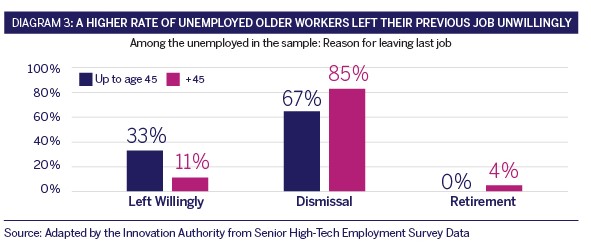The government is investing much effort in many spheres with the aim of increasing the supply of skilled workers for the high-tech industry. At the same time, we must ensure that the high-tech industry makes full use of their existing human resources in the most efficient possible manner. In other words, the industry’s ability to retain the skilled workers it recruits must be examined.
In this post, we will discuss the retention of senior high-tech employees.
Claims have been made by the public and the media that employment in the high-tech sector is unsustainable at later ages, however, these claims have not been proven empirically. High-tech employees are required to continue learning new technologies throughout their careers, some significantly different from those with which they are familiar, and to adapt to unexpected changes such as company closure or the diversion of the business focus from certain areas to others. There are those who believe that the industry’s rapid pace of change, both from a technological and a business aspect, is inherently difficult for older workers. Others indicate that the high salary levels attained by high-tech employees throughout their careers are a millstone, raising the risk of their job termination in times of crisis, in favor of younger and “cheaper” employees hired in their place. Finally, a conjecture exists according to which the industry is characterized by a pyramidical structure, so that workers promoted to middle management roles but not to senior management positions, have difficulty in finding professional fulfillment after age 45.
These claims are not unique to the high-tech sector. A study conducted by the Employment Service on the employment of older workers found that workers aged 45 and above may experience difficulties in retaining their job or in finding a suitable job – in all sectors of the labor market. Indications of these difficulties are represented by the decrease in the level of employment in this age group, and by the increase in the time period needed to find a job.[2] However, in light of the shortage in skilled high-tech labor, such a phenomenon in this sector would be surprising. If the chances of employment for skilled senior high-tech employees are indeed lower than those of younger workers, this means that the industry fails to utilize all its available human capital reserves. A proven answer to this question is critical in order to formulate appropriate policy tools for resolving the shortfall and for the cultivation of a long-term supply of skilled human capital for the high-tech industry.
Survey of Senior High-Tech Employment – Initial Findings
In order to answer this question, the Innovation Authority conducted a comprehensive survey regarding the employment of senior (older) high-tech workers. The survey was conducted in conjunction with the Association of Engineers, Architects and Graduates in Technological Sciences in Israel. The survey was widely circulated[3] and a sample of approximately 1,200 respondents was received, comprising employees or former employees in the high-tech sector or professionals from the high-tech industry who are employed or were employed in overlapping fields.
The respondents were asked about their employment situation (salaried employees, self-employed or unemployed), and about various employment characteristics such as the industry to which they work in, their salary range, the type of job/role in which they are employed, education and others. Among those who are unemployed, the survey examined different aspects of the difficulties in finding a new job. In addition, the respondents’ views with regard to the employment situation of older high-tech employees were also examined, including aspects such as obstacles to their employment and advisable solutions. This report provides initial findings from an analysis of the survey results on the basis of which the Innovation Authority will subsequently conduct a thorough study.
Table 1: Survey Characteristics – Survey of Senior High-Tech Workers
The first and most striking finding of the survey is the decline in the rate of employment with the increase in age (see Diagram 2). In other words, age has a negative influence on the chances of finding employment.[4] The survey results also reveal that the phenomenon of decreasing rates of employment are more striking among managerial personnel. It should be noted that among the unemployed respondents, the overwhelming majority are actively searching for work and only a small minority had left the labor market entirely. In other words, this is not a trend of early retirement.
A further finding relates to the variation in the employment makeup with age. The ratio of salaried employees declines as the workers increase in age, while at the same time, the ratio of self-employed workers increases. In other words, the picture being revealed shows that throughout their careers, some of the salaried-employees in the high-tech and associated fields, leave the workforce and some become self-employed.
Among those unemployed in the sample group, the overwhelming majority of the older workers (those aged 45 and over), left their previous jobs unwillingly while higher proportions of the younger workers left their last position of their own volition (Diagram 3).[5] This does not mean however that the older workers were necessarily dismissed more than the younger employees. It is feasible that the rates of dismissal are similar, but that the younger workers find a new job easier and were therefore not “caught” in the unemployed category when responding to the survey.
Additional findings relate to the widespread conjectures regarding obstacles to the employment of older workers in high-tech. The respondents were asked about the reasons that in their opinion may reduce the attractivity of employing an older worker in the high-tech field. More than half the respondents believe that high salaries constitute an obstacle,[6] even though in practice, no indication was found for a negative connection between salary level and chances of employment.[7] More than half the survey’s respondents are even of the opinion that the older workers’ failure to keep up to date technologically may reduce the attractivity of their employment. Among the younger respondents (aged 44 and less) this rate even exceeds 60 percent. In this context, the Director of Employment in the Ministry of Social Affairs, together with JDC Israel and the Technion, has recently begun operating a technology refresher course for older software engineers (see below). More than half the respondents even mentioned a difficulty in integrating into a younger social environment, and approximately 30 percent mentioned fatigue and lack of motivation.
The survey also revealed interesting findings regarding the place of the age variable in the shaping of perceptions and feelings linked to employment stability. Firstly, of the total survey sample, the difficulty for older workers in finding a new job is perceived as significant. The degree of perceived difficulty increases however with age – in other words, younger workers perceive the older workers’ difficulty in finding a new job as less significant than the older workers themselves (see Diagram 4). Secondly, the survey shows that the concern regarding future employment grows with age and reaches its peak around age 50, however after this age there is actually a decline in the degree of concern (see Diagram 5). It can be suggested that this trend is connected to the proximity to the retirement age.
If so, an initial analysis of the survey results reveals for the first time that an empiric basis exists for the claims regarding lower chances of employment in the high-tech industry for older workers, especially among the managers. Furthermore, the survey shows that high-tech workers themselves believe that there is an employment difficulty for older workers – a feeling that intensifies with age. Further analytical work is needed however in order to delve deeper into the phenomenon and better understand its various elements. In this context, the endeavor of the Director of Employment in the Ministry of Social Affairs to reintegrate older programmers into the industry (see below) may serve as a pilot for examining some of the survey’s insights, especially the aspect of remaining updated technologically. The Innovation Authority intends to examine the development of additional programs that will provide a response to this market failure and that will aid the integration of older workers.
Reintegration of Older Programmers
The Director of Employment is acting to advance the reintegration of older programmers into the high-tech industry
As part of the overall effort to address the shortage of skilled workers in the high-tech sector, the Director of Employment in the Ministry of Social Affairs recently launched a technology refresher course for older software engineers (aged 45 and over). The course is a joint initiative together with JDC Israel-Tevet, the Technion, and the “Middle of the Road” program. The refresher course aims to restore to the workforce senior software engineers who have strayed from the field of software development, through study of advanced subjects based on the participants’ relevant previous education and experience.
The course, which is concentrated into four intensive days of study a week with a total scope of 320 academic hours, emphasizes the acquiring of up-to-date knowledge such as Android software, data science, the principles of agile development, and the development of practical skills. Upon completion of the course, the participants work on a product development project in which they can express the knowledge and skills acquired during the program. During the course, the participants also receive ten hours of guidance in various aspects of employment such as updating their C.V. and preparation for job interviews.
The program is offered at a subsidized cost of approximately NIS 3000 while the cost of similar private programs can reach NIS 15000 or more. The first cycle of the program commenced in July 2017 and another is expected to open in November 2017. The program’s future expansion will be considered based on the rates of successful graduate placement.
- For further details about the next course: RikiA@jdcnet.org
We wish to thank the office of the Director of Employment at the Ministry of Labor, Social Affairs and Social Services; The Planning and Budgeting Committee at the Council for Higher Education; and to the Association of Engineers, Architects and Graduates in Technological Sciences in Israel for their contribution to this chapter.
- 1.[1] It is customary to relate to senior workers as those aged 45 and up.
- 2.[2] R. HaCohen (2014). Adult Employment in Israel, Survey on Status of Workers over 45 in the Israeli Labor Market, Israel Employment Service
- 3.[3] The survey was distributed via the internet.
- 4.[4] It should be mentioned that the age influence embodies, for example, the cohort influence, in other words, the influence of demographic or statistical differences between different age groups. An example of such a difference may be the type of technological training given to different cohorts.
- 5.[5] It should be mentioned that among those who retired, approximately half are also looking for work.
- 6.[6] Multi-choice question – other reasons were also indicated with high percentages.
- 7.[7] Within the group of unemployed, a higher salary in a previous job was not found to increase the difficulty in finding a new job. In addition, no different salary distribution was found between those employed and those unemployed, both in the total sample group and solely among the older workers.
